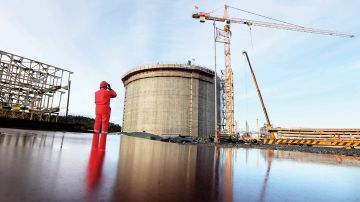NO ONE could have predicted how one man’s persistence would change the course of history.
But the ripple effects of engineer Nick Steinsberger’s work in the Barnett shale gas field – where, 20 years ago, he finally discovered the perfect liquid mix to extract gas from shale two miles underground – are still being felt today, not only in America, but all over the world.
“I don’t quite feel as if it’s down to me and initially I never thought this would happen,” he told INCH magazine from his office in Fort Worth, Texas. “At the time I was just trying to make something work. But over time, I realised the enormity of what we had achieved and it feels good to have helped to provide the world with so much cheap gas.”
This revolution – described as the most remarkable energy success story in US history – created enormous benefits in the US. For the petrochemical industry, one of the world’s biggest consumers of gas. For manufacturing which has undergone a renaissance. For communities hardest hit by the recession. And, perhaps most surprisingly of all, for the environment.
Twenty years ago there were 250 wells searching for shale gas and oil in the Barnett gas field; today there are more than 200,000.
For America’s petrochemical industry, the discovery of these vast, untapped reserves of shale gas has been phenomenal.
“US chemical investment linked to shale gas has now topped $158 billion,” said Cal Dooley, President and CEO of the American Chemistry Council.
As of January this year, 262 projects including new factories, expansions and process changes to increase capacity, had been announced.
The petrochemical industry needs natural gas to heat and power its manufacturing plants. But that gas is not just a fuel for energy. It is also a raw material used to make thousands of essential products that we all rely on each day. Without it, there would be no plastic, car parts, packaging, medical supplies, tyres, glass, clothes, or iPad screens.
“That’s often forgotten when we see heated debates about the merits of continuing to use gas,” said Greet Van Eetvelde, INEOS Head of Energy and Innovation Policy. “Many components of renewables, such as the blades of wind turbines and the lubricants in their gearboxes, also cannot be made without gas and oil.”
And shale gas is making it a lot cheaper to do it.
“The US chemical industry renaissance is just getting started,” Kevin Swift, chief economist of the American Chemistry Council, wrote in the trade group’s Year-End 2015 Chemical Industry Situation and Outlook. “The fundamentals are strong. Key domestic end-use markets expanded, consumer spending accelerated, the job market began to firm, and households enjoyed extra savings from lower energy costs.”
And INEOS, which has 17 manufacturing sites in the US, is sharing in that good fortune.
Later this year INEOS and Sasol’s new plant at INEOS Battleground Manufacturing Complex at LaPorte in Texas is expected to start paying its way.
The plant, which is a 50/50 joint venture, will be able to produce 470,000 tonnes of high density polyethylene a year for the American market. With the site expected to grow, INEOS is also poised to finalise plans to invest in a more fuel-efficient combined heat and power system which will also help to reduce CO2 emissions.
In December The Boston Consulting Group published a report, Made In America, Again.
“The number of companies actively moving production back to the US continues to increase,” said a spokesman. “In fact the US has surpassed China as the most likely destination for new manufacturing capacity.”
Part of the reason is lower energy costs, driven by shale, coupled with rising wages in China.
Apple, the world’s largest technology company, cited those reasons for its decision to manufacture its Mac Pro personal computer – described as the most powerful Mac ever built – in Texas.
It is all so different to a decade ago when the US was among the most costly places in the world for plastics producers.
“Today, America is one of the most attractive places in the world to invest in plastics manufacturing,” Steve Russell, ACC’s vice president of plastics, said last year. “Even after recent declines in oil prices, our nation has a decisive edge.”
America is now looking to capitalise on all those investments and sell to the world, a move described by Cal Dooley last year as the ‘surest path to a stronger economy and new jobs’.
Global adviser Nexant is forecasting dramatic growth in US chemical exports over the next 15 years.
In its 2015 Fuelling Export Growth report, it suggested sales of $123 billion by 2030 – more than double what chemical manufacturers exported in 2014.
But there is also a growing appetite among Americans for products ‘Made in the USA’.
One who understands that is Harry Moser, a veteran of the manufacturing industry and former president of machine tool maker GF AgieCharmilles, who in 2010 founded Reshoring Initiative to help companies re-evaluate whether to come home,
“I had watched with dismay as more and more US jobs went, at first, to Japan, then Mexico, Taiwan, Korea and finally China,” he said. “The impact on the US economy was horrible with the loss of millions of manufacturing jobs. The United States used to be the world’s industrial powerhouse, and I had grown up experiencing its glory.”
Since he founded Reshoring Initiative, about 1,000 companies have come home, bringing with them almost 100,000 jobs.
“I am delighted with the response of the nation and many companies,” he said. “Sadly, though, many companies are still trapped in the ‘buy at the cheapest price’ mode instead of considering the total cost. It will take decades to overcome the MBA mentality.”
Apple’s decision to manufacture its Mac Pro in America was also part Chief Executive Officer Tim Cook’s $100 million Made-in-the-USA push.
“We don’t want to just assemble the Mac Pro here,” he said. “We want to make the whole thing here. This is a big deal.”
In January this year America’s oldest hatmaker Bollman announced that it was moving 41 jobs back from China to its plant in Adamstown, Pennsylvania. It had launched an appeal in November for the public’s help in raising $100,000 to import 80 knitting machines, built in 1938, that weave the fabric for its famous Kangol 504. The public took its hat off to the company’s attitude – and responded.
“Reshoring is the fastest and most efficient way to strengthen the US economy because it demonstrates that manufacturing is a growth career,” said Harry. “And without manufacturing, a country becomes progressively poorer.”
But it is not just industry which has benefited from low-cost feedstock and energy prices.
Shale gas has revitalised communities, including some hardest hit by the recession.
The Associated Petroleum Industries of Pennsylvania said natural gas development had supported hundreds of thousands of jobs in Pennsylvania, contributed $34.7 billion annually to the state economy and had boosted profits in more than 1,300 businesses of all sizes up and down the energy supply chain.
“Safe, responsible natural gas development has been good for the state economy, good for local economies and good for Pennsylvanians,” said Executive Director Stephanie Catarino Wissman. “And we want to keep it that way.”
At Marcus Hook, the site of a former crude oil refinery which closed in 2011 with the loss of 500 jobs, there is now a real sense of excitement.
The former refinery, which had produced gasoline, diesel and kerosene for 109 years, is being transformed into a major centre for processing and shipping natural gas liquids thanks to its links with the Marcellus shale industry.
“The idling of the Marcus Hook Refinery was a difficult time for the Borough of Marcus Hook, for the Sunoco family, and for the whole region,” said Hank Alexander, vice-president, business development of Sunoco Logistics Partners LP. “But now the town is buzzing again, from downtown restaurants to local contractor facilities. And some of the workers who lost their jobs in 2011 are back working at the plant.”
Sunoco Logistics had bought the old refinery in 2013, with the intention of linking it to the Marcellus shale, which now produces almost 20% of America’s natural gas, compared to nothing 10 years ago.
Management believed the existing infrastructure for ship, rail, truck and pipeline positioned it as a hub for natural gas liquids.
“We wanted to develop manufacturing enterprises that would recapture jobs and help revitalise manufacturing in the region,” said Hank. “The shale gas boom had re-animated towns such as Marcus Hook.”
Mario Giambrone owns Italiano’s restaurant in Marcus Hook. “You can talk about it anyway you like in terms of the number of hoagies and pizzas but this is a godsend for this town and my business,” he told the Pennsylvania Manufacturers’ Association.
David Taylor is President of that association, which is the leading voice for manufacturing in Pennsylvania. “The energy sector has almost singlehandedly kept Pennsylvania’s economy afloat during the recession and over the past few years,” he said.
Developing energy from the Marcellus shale has also turned nearby Williamsport into the seventh fastest-growing metropolitan area in America.
Dr Vince Matteo, President and CEO of Williamsport Lycoming Chamber of Commerce and Industrial Properties Corporation, said the vast majority of people locally had embraced the shale gas boom.
“It was a game-changer for us,” he said. “I had never seen anything like it. At one point more than 85 businesses moved to the county, which led to the opening of countless restaurants and four new hotels.”
Meanwhile, Williston, a once sleepy town in North Dakota, suddenly became the fastest-growing small city in America due to the oil boom again with new restaurants, new shops and new faces.
Communities also benefited from the unexpected revenue streams from companies drilling for shale gas, which allowed them to make improvements that otherwise might not have been possible.
“Having that funding source has been a tremendous boom to us,” Lisa Cessna, the executive director of the local planning commission in Washington County, just outside Pittsburgh, told The Associated Press. “It has helped build fishing piers, playgrounds and walking trails.”
She told the Associated Press that there had been complaints about drilling sites on public land but said the end result outweighed the negatives.
“You can make it work,” she said. “There are going to be bumps in the road. You’re going to upset some people. We insisted on special legal language that gives us control over many aspects of the drilling process. We approve every pipeline, well pad, access road. It’s labour intensive, but it’s worth it. The most important message is to maintain full control.”
But one of the biggest surprises of all has been the effect of shale gas on the air we breathe with America’s CO2 emissions falling to their lowest level for 20 years in 2012.
The reason? Gas, which became the fuel of choice to generate electricity instead of coal which emits twice the CO2.
Despite all the benefits, though, not all – even those in incredibly high places – are championing shale gas.
“President Obama’s animosity to fossil fuels prevents him from recognising the most remarkable energy success story in US history, maybe in all of world history,” said Dr Mark Perry, a scholar at the American Enterprise Institute and professor of economics at the University of Michigan. “But we need a president who will acknowledge it.”
Dr Perry said shale oil had:
Significantly reduced America’s dependence on foreign oil and petroleum from often unstable parts of the world.
Helped to bring down gasoline prices and prevented the Great Recession from being even worse and lasting much longer.
“Domestic energy production creates US jobs and generates royalties for landowners and tax revenues for the governments, state, local and federal,” he said. “And the drop in US gas prices to a seven-year low will save American consumers more than $100 billion in lower energy costs this year.”
















